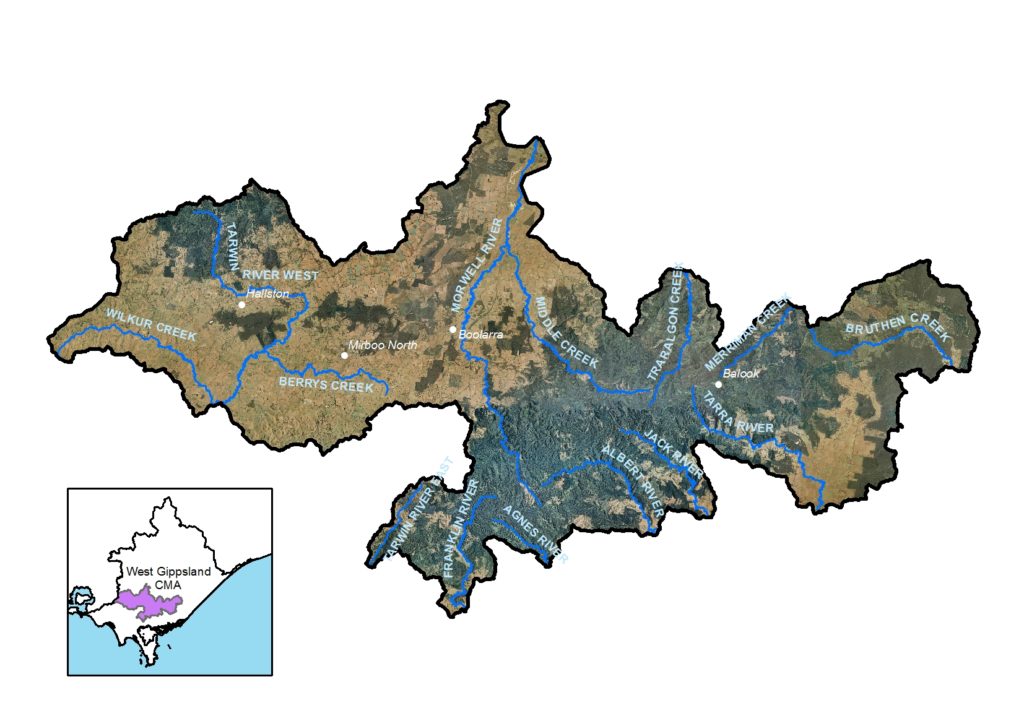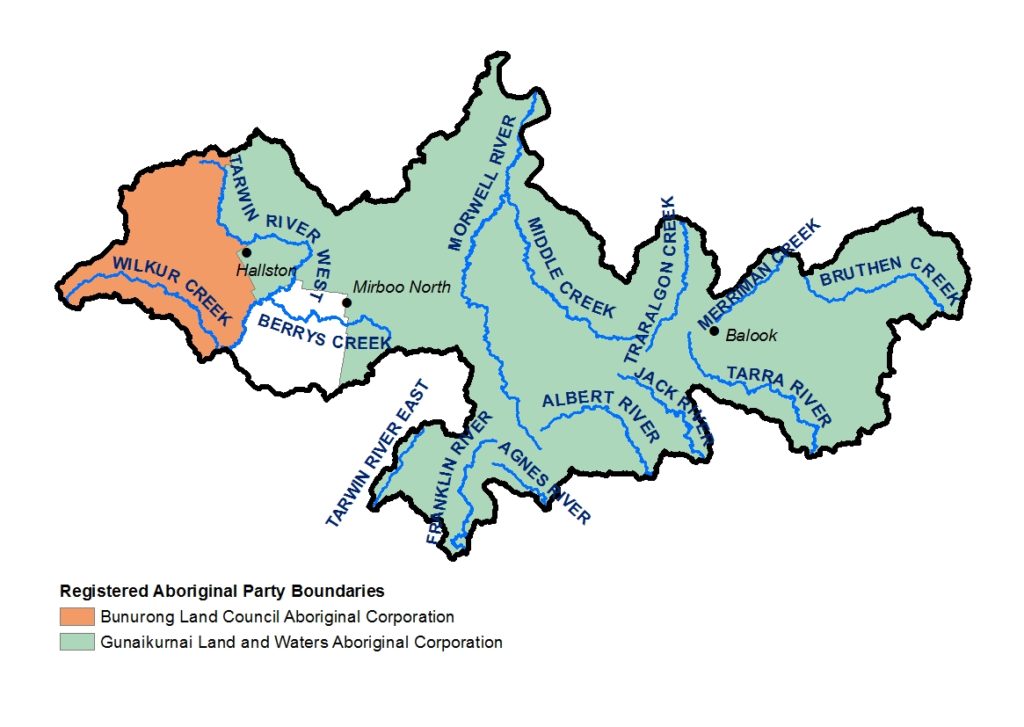Introduction
The Strzelecki local area includes the Country of the Bunurong Traditional Owners and the Gunaikurnai Traditional Owners. At present, there are also parts of the local area where formal recognition is not in place. Traditional Owners have a deep and continuing connection to the area and have an ongoing role in caring for Country.
The Strzelecki local area incorporates the steep range of hills that divide the southern part of the West Gippsland region.
The Strzelecki Ranges are a fragmented landscape with a low proportion of habitat protected through the reserve system. The local area receives high rainfall and supports wet forests and rainforest vegetation communities on the higher slopes grading to lowland forest and shrubby dry forest in the foothills. Almost the entire western part of the local area was cleared in the late 19th and early 20th centuries. The eastern parts of the Strzeleckis tend to have more native vegetation cover and feature some significant conservation areas like Tarra-Bulga National Park and Mt Worth State Park, Morwell National Park, Mirboo North Regional Park and a network of smaller reserves1. These features attract visitors to the area and provide valuable habitat for threatened flora and fauna as well as the genetically diverse South Gippsland koala population.
Waterways include those that flow north into the Latrobe Valley such as the Morwell River and Narracan Creek as well as those that flow south to the coast including the Tarwin, Franklin, Agnes, Tarra and Albert Rivers. Water is an important resource for the environment, stock, domestic, urban supply and horticulture.
The lower foothills, particularly on the western and southwestern parts of the range, have deep soils suitable for agriculture. These areas now support grazing and vegetable cropping including potatoes.
Forestry is one of the major land uses in the Strzelecki local area including both hardwood and softwood plantations5. More recently there has been an increase in the number of lifestyle properties and smaller producers especially in the western part of the Strzelecki Ranges.
Parts of the Strzeleckis are very prone to sheet, tunnel, gully and stream bank erosion and landslips are common. These can have significant impacts on farming and water quality in the local waterways and receiving waters2.
Landcare volunteers and groups in the local area are supported by the South Gippsland Landcare Network, Latrobe Catchment Landcare Network and the Yarram Yarram Landcare Network.
Collaborative action for Biodiversity
The local area incorporates the Western Strzeleckis and Strzelecki Forests landscapes of interest for Biodiversity Response Planning.
The landscapes of interest support a range of threatened species and important habitat. Biodiversity features include Wet and Damp forests as well as the threatened Cool Temperate Rainforest (Flora and Fauna Guarantee Act 1988 (Victoria)). Other notable features include the threatened Spiny and Burrowing Crayfish species, the Giant Gippsland Earthworm, Dwarf Galaxias and the South Gippsland Koala11;2.
Snapshot
This section provides an overview of the local area condition and trends for RCS asset themes, including information for a selection of indicators from the state-wide outcomes framework.
Land
![]() Data on annual average exposed soils for the period 2000-2019 is available for the four local government areas that overlap with the Strzelecki local area. (NB: local government areas extend beyond the local area boundary).
Data on annual average exposed soils for the period 2000-2019 is available for the four local government areas that overlap with the Strzelecki local area. (NB: local government areas extend beyond the local area boundary).
The exposed soils ranges for the period 2000 – 2019 are as follows:
- Baw Baw Shire Council between 2.9% and 5.4%
- South Gippsland Shire Council between 6.5% and 8.5%
- Latrobe City Council between 6.4% and 10.3%
- Wellington Shire 4.1% and 9.9%8.
Large areas of the north and west Strzelecki Ranges are at very high risk of sheet/rill and gully erosion and landslip with potential to impact on waterways and productivity10.
![]() Non-native pasture (associated with livestock enterprises) is the dominant land cover type in the local area (60,684 ha), followed by native trees and shrubs (56,887 ha) and forestry (31,912 ha)5.
Non-native pasture (associated with livestock enterprises) is the dominant land cover type in the local area (60,684 ha), followed by native trees and shrubs (56,887 ha) and forestry (31,912 ha)5.
![]() Between 1985 and 2019 the following land uses increased:
Between 1985 and 2019 the following land uses increased:
- Exotic woody plants
- Urban
- Dryland cropping
- Irrigated horticulture
- Forestry land uses5.
![]() The combined production value of agriculture for the year 2015-16 was $144.9M. Milk production was the major commodity, followed by cattle, calves and vegetables. Hay, sheep, lambs and wool are smaller contributors to the economy of the local area6.
The combined production value of agriculture for the year 2015-16 was $144.9M. Milk production was the major commodity, followed by cattle, calves and vegetables. Hay, sheep, lambs and wool are smaller contributors to the economy of the local area6.
Biodiversity
![]() The cover of native trees remained stable for the period 1985-2019, although representing a much smaller proportion of land cover5.
The cover of native trees remained stable for the period 1985-2019, although representing a much smaller proportion of land cover5.
There were losses in the following:
- -67% native herb grass
- -65% native shrubs
- -41% native scattered trees
- -21% natural low cover.
![]() 4,276 ha of habitat is permanently protected through the reserve system (about 2% of the total area)13.
4,276 ha of habitat is permanently protected through the reserve system (about 2% of the total area)13.
422 ha of habitat on private land was permanently protected through the establishment of Trust for Nature covenants, between 2000-2019.
Water
The Water snapshot provides a summary from the Long Term Water Resource Assessment for Southern Victoria.
The Strzelecki local area includes the headwater reaches of waterways in the South Gippsland basin and the Latrobe basin.
Water availability for most rivers in the South Gippsland basin declined (the Franklin River experienced a small increase), with the majority of water available to the environment through above cap flows.
Waterways in the Latrobe basin experienced a decline in water availability. Water available to the environment in the Latrobe basin has declined due to a reduction in water available from spills (from reservoirs in other local areas) and a decline in unregulated inflows3.
Waterways and wetlands
During the period 2000-2019, the following were improved:
- 469 km waterway
- 3,192 ha riparian land.
This included 1,313 ha weed control and 443 ha revegetation activities.
![]() There was a loss of wetlands between 1985-2019, with perennial wetlands declining by 66% and seasonal wetlands by 45%5.
There was a loss of wetlands between 1985-2019, with perennial wetlands declining by 66% and seasonal wetlands by 45%5.
Community
The local area includes the major town of Mirboo North with smaller rural communities, including Hallston and Seaview in the west and Balook in the east.
The population of Mirboo North has gradually increased since 1976 and in 2016 was 2,326. It is forecast to grow to 2,476 by 2036. In terms of migration, the area has mainly attracted people from other places of Victoria4.
Current and Future Challenges
![]() Key challenges in the Strzelecki local area include:
Key challenges in the Strzelecki local area include:
- Poor water quality
- Pest plants on private and public land
- Habitat fragmentation and the lack of habitat permanently protected on private and public land.
The impacts of climate change including the increased risk of wildfire are major challenges for integrated catchment management. Residents have concerns around the implications of reduced water availability and increased temperatures on land production and biodiversity.
The expansion of deer populations in this local area has been highlighted as a key challenge by agency partners and the community, with concerns about the impacts on waterways, vegetation and agricultural land.
Engaging with people new to the area and securing sufficient funds for new and ongoing programs have been highlighted as key concerns by agency partners.
Other emerging challenges include competition for land, change in land value and intesification of land management practices.
The impacts of increased visitation and inappropriate behaviour, such as rubbish dumping and illegal timber harvesting are also a concern in this local area.
Overview of current and future management challenges for the Strzelecki Local Area
| KEY MANAGEMENT CHALLENGES FOR LAND, WATER AND BIODIVERSITY | LAND | WATER | BIODIVERSITY | COMMUNITY CONCERNS |
|---|---|---|---|---|
| Erosion and soil degradation | ✔ | ✔ | ✔ | |
| Pest plants | ✔ | ✔ | ✔ | ✔ |
| Pest animals | ✔ | ✔ | ✔ | ✔ |
| Land management practices (includes timber harvesting, land and livestock management practices) | ✔ | ✔ | ✔ | |
| Land use change/population pressures | ✔ | ✔ | ✔ | |
| Poor water quality (as the result of excess nutrients, sedimentation, oil spills and other pollutants) | ✔ | ✔ | ||
| Habitat fragmentation | ✔ | ✔ | ✔ | |
| Recreational use and visitation impacts (includes facilities, activities and access) | ✔ | ✔ | ✔ | |
| Inappropriate fire regimes and risk of fire | ✔ | ✔ | ✔ | |
| Climate change and related extreme events (eg. wildfire, flood, drought) | ✔ |
Opportunities and Priorities
The Traditional Owners of this local area, the Bunurong and Gunaikurnai peoples, have cared for this Country for thousands of years. Their place-based aspirations and priorities are outlined in the Bunurong Country Plan (in preparation) and Gunaikurnai Whole of Country Plan.
Community members and agency partners have highlighted a desire to come together and undertake whole of landscape planning for the Strzelecki local area and coordinate efforts for land, water and biodiversity.
The tables below set out the overarching Traditional Owner priorities that are relevant across all the local areas and the other opportunities and priorities for agency partners and the community for this local area.
| TRADITIONAL OWNER PRIORITIES |
|---|
| ◾ Protecting cultural heritage from pressures associated recreation, land use changes and climate change |
| ◾ Actively managing the water, fire, wildlife and biodiversity on Country in a culturally appropriate way |
| ◾ Having the authority to lead managing Country on behalf of the rest of the community |
| ◾ Seeking carbon production through forest restoration |
| ◾ Participation in economic opportunities, including employment and enterprise development associated with caring for Country |
| ◾ Access to water to restore customary practices, protect cultural values and uses and heal Country |
| ◾ Secure water rights to restore and reserve waterways and practice self-determination on how and where water is used for cultural, environmental or economic purposes. |
| OTHER LOCAL AREA OPPORTUNITIES AND PRIORITIES |
|---|
| ◾ Protect and improve biodiversity through permanent protection and targeted actions to reduce threats |
| ◾ Implement the Strzelecki-Alpine Biolink, including establishing provisions in local planning schemes |
| ◾ Undertake integrated control programs to address pest plants and animals (including the increasing impact of deer) |
| ◾ Increase community awareness of the environment and provide opportunities for community participation |
| ◾ Investigate and implement planning scheme measures to manage potential impacts from development/population growth on agricultural land, water quality and biodiversity |
| ◾ Support farmers and forestry operations to implement practices that improve land management and reduce off-site impacts |
| ◾ Support Traditional Owners’ aspirations for and participation in land, water and biodiversity management |
| ◾ Investigate and implement options to address water recovery targets (for Traditional Owner, environmental and recreational values) |
| ◾ Complete works to protect and rehabilitate waterways and riparian areas. |
Community perspectives
What does the Strzelecki local area look like in the future?
“Protection of the natural environment, respect for farming communities, and an acknowledgement of the effort of landholders put in to protect the waterways when their land has river frontage.”
“A comprehensive feral animal and weed control strategy across the landscape.”
“Waterways are buffered and native vegetation corridors and reserves are linked.”
The top land, water and biodiversity management actions identified by community members were:
- Control pest plants
- Control pest animals
- Retain and restore native vegetation communities
- Fencing of waterways and native vegetation
- Planning scheme changes to protect agriculture and biodiversity
- Community/landholder awareness programs
- Incorporate traditional ecological knowledge in the planning and delivery of programs
- Improving agricultural/land land practices (weeds, water quality etc.).
The top areas of focus for climate change adaptation were:
- Maintain a diversity of habitats, environments and species to maximise the chance of survival
- Incorporate traditional ecological knowledge into climate change adaptation
- Conduct monitoring and research that improves our ability to plan for and adapt to climate change.
The top areas for helping communities and industries to participate in land, water and biodiversity management were:
- Grants or incentives to undertake projects
- Collaboration between agencies and community/industry on projects at a local level
- Information/advice to improve knowledge.
Management Directions and Regional Outcomes
Management directions are the overarching strategies to guide agency and community collaboration. The agency and community priorities outlined above will help to realise the management directions at the local area scale.
Implementation will be guided by regular Local Area partnership forums and implementation planning processes that prioritise effort with consideration to value for money, and issues of feasibility and risk.
Priority management directions have been defined for each theme: Land, Water, Biodiversity, Coast and Marine, Community, Traditional Owners and Climate Change.
The RCS outcomes hierarchy can be found here with a more detailed matrix showing how the medium term outcomes align to local areas here.
Further details on RCS implementation can be found here.
References
- WGCMA. West Gippsland Regional Catchment Strategy 2013- 2019. Traralgon: West Gippsland Catchment Management Authority, 2013
- WGCMA. West Gippsland Regional NRM Climate Change Strategy. Traralgon: West Gippsland Catchment Management Authority, 2016
- DELWP. Long Term Water Resource Assessment for Southern Victoria. Basin by Basin Results. East Melbourne: Department of Environment, Land, Water and Planning, 2020
- SGSC. Spotlight on Mirboo North. Leongatha: South Gippsland Shire Council, 2018
- DELWP. Victorian Land Cover Time Series Data 1985 – 2019 . East Melbourne: Department of Environment, Land, Water and Planning, 2020a
- ABS. Agricultural Census: Agricultural Data – 2005-06, 2010-11 and 2015-16. Canberra: Australian Bureau of Statistics, 2020
- RMCG. West Gippsland Regional Catchment Strategy Review and Renewal Report. Prepared by RMCG for the West Gippsland Catchment Management Authority, 2020
- Van Dijk, A and Summers, David. Australia’s Environment Explorer, The Australian National University. Exposed Soil. [Online] 27 November 2020
- BLCAC. Bunurong Land Council Aboriginal Corporation Appointed Registered Aboriginal Parties Area. Frankston: Bunurong Land Council Aboriginal Corporation, Undated
- WGCMA. West Gippsland Soil Erosion Management Plan. West Gippsland Catchment Management Authority, 2008
- DELWP. Biodiversity Response Planning Fact Sheets. Department of Environment, Land, Water and Planning. [Online] 2021
- id. South Gippsland Shire Population Forecast. .idcommunity demographic resources. [Online] 17 3 2020
- DAWE. Collaborative Australian Protected Areas Database (CAPAD) – Terrestrial & Marine. [Spatial Layer] Canberra : Department of Agriculture, Water and the Environment, 2021
- GLAWAC. Gunaikurnai Whole of Country Plan. Gunaikurnai Land and Waters Aboriginal Corporation. 2015.






